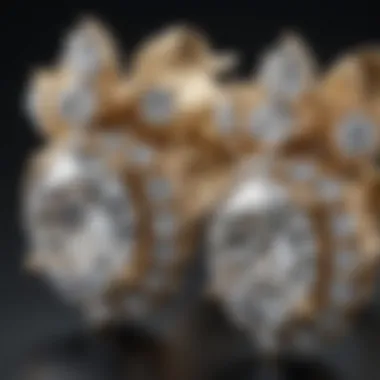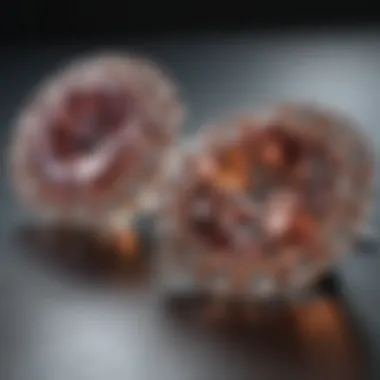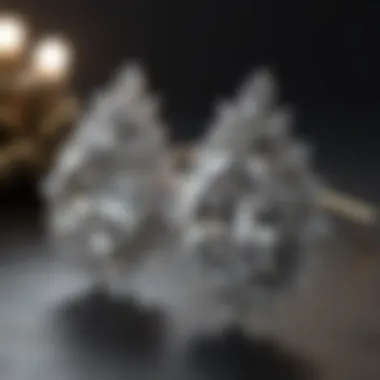Understanding the Cost of One Carat Diamond Earrings


Intro
Gemstone Overview
Definition and Characteristics
Diamonds, as gemstones, are renowned for their brilliance and clarity. A carat is a specific weight measurement, typically denoting 200 milligrams. The size of a diamond affects its appearance but is not the sole determinant of value. The
Four Cs of diamonds—carat, cut, color, and clarity—play critical roles.
- Cut refers to how well the diamond has been shaped. A well-cut diamond shows better light reflection.
- Color is graded on a scale, with colorless diamonds being the most sought after.
- Clarity indicates the presence of inclusions or blemishes within the stone.
These factors combine to form a comprehensive picture of a diamond's worth, impacting the price of one carat diamond earrings significantly.
Classification of Gemstones
Gemstones can be classified based on various criteria, including hardness, chemical composition, and crystal system. Diamonds are categorized in the hardness scale known as Mohs, which ranks them at the top with a score of ten. This classification reflects their durability and reasons for their popularity in jewelry.
Historical Significance
Ancient Uses and Cultural Importance
Throughout history, diamonds have held various meanings. They have represented strength, wealth, and even purity. In ancient cultures, diamonds were often believed to be mystical stones; warriors wore them for protection during battles. Today, diamonds often symbolize enduring love, particularly in engagement rings and other fine jewelry.
Myths and Legends Surrounding Gemstones
Various myths exist about gemstones, particularly diamonds. One popular belief is that diamonds can bring good luck or grant wishes. Such tales often enhance the allure of diamonds, contributing to their high demand and prices.
"The intrinsic value of diamonds extends beyond their physical attributes. It encompasses culture, history, and emotion."
Epilogue
The cost of one carat diamond earrings is not a straightforward figure. Understanding the grading elements, historical importance, and trends in the market can aid in making educated choices. By exploring these facets, potential buyers can appreciate the complexity involved in diamond pricing.
Preface to One Carat Diamond Earrings
In the realm of fine jewelry, one carat diamond earrings are often regarded as a quintessential choice. Their beauty and versatility make them a favorite among gemstone enthusiasts and collectors. Understanding the cost of these earrings is crucial for anyone looking to make an informed purchase. Factors influencing their pricing extend beyond mere aesthetics.
The significance of carat weight, clarity, cut, and color plays an essential role in determining value. Moreover, the market dynamics and trends can shift prices remarkably. This article aims to dissect these elements, presenting readers with a comprehensive guide on what to consider when buying one carat diamond earrings.
Defining One Carat Diamonds
A carat is a unit of weight used for diamonds and other gemstones, with one carat equating to 200 milligrams. However, it is important to note that the carat weight does not directly correlate with size. The actual appearance of the diamond depends on its cut and proportions as much as its weight.
When discussing one carat diamonds, shoppers often seek clarity and color grades that complement the carat weight. This combination affects not just the diamond's visual appeal but also its price. Higher quality diamonds typically command higher prices, especially in the one carat range.
Significance of Earrings in Jewelry
Earrings serve a dual function: they enhance personal style and make a statement. One carat diamond earrings, in particular, can embody elegance and luxury. They are appropriate for various occasions, from formal events to everyday wear. The versatile nature of earrings allows them to be worn by anyone, regardless of age or style preference.


Furthermore, diamond earrings hold a symbolic value. They are often given as gifts for special occasions such as anniversaries or birthdays. This emotional connection further elevates their importance in the jewelry market. Hence, understanding one carat diamond earrings goes beyond mere cost analysis to include their cultural and emotional significance.
Factors Influencing the Cost
The cost of one carat diamond earrings is shaped by a variety of factors. Each element plays a significant role in determining the final price tag. Understanding these factors is crucial for buyers who want to make an informed purchase. By analyzing these influences, one gains insights into how pricing works in the diamond market.
The Four Cs of Diamonds
The Four Cs—Cut, Color, Clarity, and Carat Weight—create a fundamental framework for evaluating diamonds. The interplay of these criteria influences both the quality and the price of diamond earrings.
Cut
Cut refers to how well a diamond has been shaped and polished. It affects the stone's ability to reflect light and sparkle. A well-cut diamond reflects light beautifully, resulting in greater brilliance and fire. This aspect makes cut one of the most important factors influencing the overall look of a diamond earring. Diamonds with excellent or ideal cut grades tend to attract higher prices. On the flip side, poorly cut diamonds can look dull and fail to showcase their potential. Therefore, investing in a high-quality cut can significantly enhance the visual appeal of diamond earrings.
Color
The color of a diamond directly impacts its value. Color grades range from colorless to shades of yellow and brown. A colorless diamond, which appears more transparent, is generally more desirable. The rarest and most valuable diamonds feature no color at all. However, many buyers might prefer diamonds with slight tints in certain jewelry settings. This characteristic can provide unique aesthetic options. Buyers should note that while color has a significant impact on pricing, personal taste also plays a crucial role in selecting diamonds for earrings.
Clarity
Clarity refers to the presence of internal or external imperfections, known as inclusions or blemishes. A diamond with high clarity contains few, if any, visible flaws. Such diamonds command premium prices due to their rarity. Conversely, diamonds with noticeable inclusions often see a dip in market value. Understanding clarity is essential when evaluating one carat diamond earrings. Buyers must weigh the visibility of these imperfections against their own preferences and budget. Clarity is not just a technical specification; it is about understanding the balance between beauty and price.
Carat Weight
Carat weight measures the size of the diamond. While a one carat diamond is often preferred, the correlation between weight and price is not direct. Two diamonds of equal carat weight can differ significantly in value based on their other characteristics. Larger diamonds are rarer, thus more expensive, but buyers should remember that quality factors—cut, color, and clarity—are equally critical. A well-rounded assessment of these attributes is paramount to making a suitable investment in diamond earrings.
Market Demand and Trends
Market demand can fluctuate based on trends, which significantly affect pricing. Understanding current trends can give buyers insights into the timing of their purchases. For instance, during certain seasons or holidays, demand for diamond earrings may increase, leading to higher prices. Moreover, the rise of eco-friendly and sustainable diamonds has shifted buying patterns. Awareness of such trends can help buyers navigate price changes in the marketplace.
Impact of Brand on Pricing
The brand also plays a fundamental role in pricing one carat diamond earrings. Established and luxury jewelry brands often command premium prices due to their reputation and quality assurance. Shoppers might pay more for items from brands like Tiffany & Co. or Cartier, considering factors such as craftsmanship and design. However, there are high-quality options from lesser-known brands that may offer better value. Selecting a reputable brand that aligns with quality standards is essential for those seeking lasting value in their diamond earrings.
Comfort and Aesthetics
When considering one carat diamond earrings, comfort and aesthetics play a significant role. The way these earrings feel and how they look can greatly influence the purchasing decision and long-term satisfaction. A well-designed pair of diamond earrings should not only dazzle in appearance but also fit comfortably.
Choosing the Right Setting
The setting of diamond earrings refers to the way in which the diamonds are mounted. Different settings can dramatically affect comfort. For instance, stud earrings tend to sit closer to the earlobe and can be less obtrusive. In contrast, drop earrings might sway when you move, creating a different wearing experience.
It is also important to consider the material and style of the setting. Gold, platinum, and even hypoallergenic materials like titanium can impact comfort levels. A setting that is too heavy may cause discomfort after extended wear. Additionally, sharp edges or poorly designed clasps can lead to irritation.
A few key points on selecting the right setting include:
- Ear sensitivity: If you have sensitive skin, opt for higher-quality metals.
- Earring weight: Balance is vital; too heavy settings can cause strain on the lobes.
- Personal activity level: Consider how active you are; some settings may be better suited for an active lifestyle.
Visual Appeal and Personal Style


The aesthetic quality of one carat diamond earrings cannot be overstated. They are often a statement piece in any jewelry collection. Choosing earrings that resonate with your personal style enhances their visual appeal. Whether you prefer a classic look or something more modern, the right design is essential.
There are different design variations to consider:
- Simple Solitaires: These understated designs highlight the diamond itself.
- Halo Settings: These provide an extra sparkle around the main diamond with a surrounding array of smaller diamonds.
- Vintage Styles: Often intricate, these designs incorporate unique patterns and craftsmanship.
Finding earrings that match your personal style will ensure they are worn frequently. Comfort must align with aesthetics for a satisfying experience. As you evaluate different options, keep in mind how the earrings align with your wardrobe.
"The best earrings are those that feel like a natural extension of oneself."
By understanding comfort and aesthetics, you can make a choice that is pleasing both to the eye and to the ear. A thoughtful balance of these components will guide your decision-making in acquiring one carat diamond earrings.
Comparative Pricing Analysis
The comparative pricing analysis is essential for those looking to invest in one carat diamond earrings. This section examines how different pricing structures can affect purchase decisions. By analyzing the differences between retail and online pricing, as well as the second-hand market, consumers can better understand market behaviors and price variations. The insights gained from this analysis empower buyers to make informed choices, ensuring they are not overpaying for their diamond earrings.
Retail Pricing vs. Online Pricing
Retail pricing for diamond earrings typically reflects the traditional shopping experience. When purchasing in-store, buyers might benefit from direct interaction with sales associates, who can provide valuable insights into the quality and history of the earrings. However, this personal touch often comes at a premium. Local jewelers incur various overhead costs such as rent and employee wages, which are then passed on to the consumer.
On the contrary, online pricing usually offers more competitive rates. This divergence can be attributed to lower operational costs for online retailers. They often have limited physical storefronts or operate entirely online, driving down prices.
Factors to consider in retail vs. online pricing include:
- Convenience: Online shopping allows comparison across multiple platforms quickly.
- Inspection: In-store purchases provide an opportunity to physically inspect the earrings.
- Shipping Costs: While online retailers might offer lower base prices, shipping fees can add up.
- Return Policies: Retailers may have different return and warranty procedures.
As such, potential buyers should weigh these factors against their personal priorities. Some may prefer the assurance that comes from examining the earrings in person, while others might prioritize finding the best deal online.
Second-Hand Market for Diamond Earrings
The second-hand market for diamond earrings presents an interesting dynamic. Many consumers are increasingly exploring pre-owned options due to the value they offer. When well-maintained, diamond earrings can retain their beauty and quality over time. Often, these earrings are available at significantly lower prices than new ones, allowing buyers to acquire high-quality jewelry without the inflated costs of brand new pieces.
Considerations when buying from the second-hand market:
- Quality Verification: Buyers should ensure that the diamonds are certified by reputable entities.
- Condition: Inspecting the condition of the earrings is crucial since wear can impact aesthetics.
- Historical Value: Some second-hand earrings may have a unique story or backstory that adds sentimental value.
When considering the second-hand market, research plays a vital role. Buyers should familiarize themselves with online platforms such as Facebook Marketplace, Craigslist, or specialized jewelry resale sites. This thorough investigation can lead to excellent value without sacrificing quality.
"Engaging in comparative pricing analysis can tremendously impact the purchasing experience, leading to sound investment in diamond earrings."
Understanding these elements helps create a clearer picture of the overall value proposition when considering one carat diamond earrings. Knowing the pricing structures allows potential buyers to navigate their choices confidently.
Budget Considerations
When it comes to purchasing one carat diamond earrings, setting a budget is crucial. Jewelry can often come with unexpected costs. Understanding your financial limit ensures that you do not overspend. Often, buyers fall in love with a piece that exceeds their initial plans. Examining your budget also allows for a clearer exploration of options that meet your quality expectations without stretching finances too thin.
Setting a Realistic Budget
Establishing a realistic budget is fundamental when considering diamond earrings. First, evaluate your financial situation. Consider factors such as savings, income, and other expenses.


Aspects to consider when setting a budget:
- Quality vs. Cost: Higher quality diamonds typically demand a premium price. It may be beneficial to prioritize attributes important to you.
- Research Pricing: Understanding average market prices for similar earrings can aid in realistic budgeting. Websites like en.wikipedia.org and britannica.com offer insights on pricing structures.
- Future Maintenance Costs: Small amounts for repairs or service should be included. It can prevent surprises down the line.
Maintain flexibility within your budget to accommodate unique findings. Special designs or rare diamonds may warrant increased spending.
Financing Options for Purchases
For many, purchasing diamond earrings outright may not be feasible. Thankfully, there are several financing options available. These can make expensive items more accessible, allowing for enjoyment without immediate full payment.
Financing methods may include:
- Credit Plans: Retailers often provide special financing plans, enabling payments over time. Review the terms; interest rates sometimes apply.
- Personal Loans: Consider taking a personal loan for larger purchases. Rates and terms vary widely, so assess your options carefully.
- Layaway Plans: Some jewelry stores offer layaway methods, where you pay in smaller increments before receiving the item. This can help spread the cost over time without debt.
Evaluate each method to see what aligns best with your financial situation.
Investing in diamond earrings should not lead to financial strain. Carefully consider all options before making a commitment.
Maintenance and Care of Diamond Earrings
Maintaining diamond earrings, especially those featuring one carat diamonds, is crucial for preserving their brilliance and longevity. Regular care helps avoid damage, maintains their aesthetic appeal, and can even uphold their value over time. Since diamond earrings often represent a significant emotional and financial investment, understanding the best practices for caring for them becomes essential.
Cleaning Practices
Cleaning diamond earrings is a fundamental part of their maintenance. Dirt, oils, and grime can accumulate over time, dulling the diamond's sparkle. To clean your diamond earrings effectively, use the following methods:
- Use Mild Soaps: Mix warm water with a few drops of mild soap. Soaking the earrings can loosen any debris.
- Soft Brushes: A soft toothbrush or a dedicated jewelry brush can help you reach tight spaces without scratching the surface.
- Rinse Thoroughly: After cleaning, rinse the earrings with clean water to remove any soap residue. Be careful not to drop them down the drain.
- Dry Gently: Use a soft, lint-free cloth to gently dry the earrings.
It is important to note that ultrasonic cleaners are an option, but not all diamond settings are safe for such a method. Always check if your earrings are suitable for that type of cleaning.
"Regular cleaning will protect your investment, making sure your diamonds remain as radiant as when you bought them."
Storage Recommendations
Storing diamond earrings properly is another critical factor that affects their condition. Poor storage can lead to scratches or tangling with other jewelry. Here are a few effective storage tips:
- Separate Storage: Always store diamond earrings separately from other jewelry. This can prevent scratches and abrasions. Consider using a dedicated, padded jewelry box.
- Avoid Humidity: Keep the earrings in a dry place to avoid moisture that could lead to tarnish or corrosion of the setting.
- Use Soft Bags: Storing earrings in separate soft bags can provide extra protection from potential damage.
- Check Settings Regularly: Periodically inspect the earring settings for signs of wear or loose prongs. Address any issues promptly to prevent losing the stone.
By following these cleaning practices and storage recommendations, you can ensure that your one carat diamond earrings remain stunning for years to come.
Finale
In a marketplace where every detail counts, recognizing the factors that contribute to the value of diamond earrings can lead to more sensible purchasing decisions. For example, grasping the nuances of the Four Cs (cut, color, clarity, and carat) provides insight into what makes a specific pair of earrings more or less desirable. This knowledge allows buyers to prioritize features that genuinely resonate with their personal taste and financial constraints.
Moreover, understanding market trends can inform buyers about when to purchase and what might provide good investment potential. As the market for diamonds shifts, being aware of these trends is more important than ever.
In summary, the discussion about one carat diamond earrings culminates in making informed choices while appreciating the artistry and significance behind each piece. Generating a conversation around informed spending can elevate the experience of buying fine jewelry, ensuring purchasers feel confident in their selections. By becoming educated on these topics, collectors and enthusiasts can truly engage with their purchases on a more meaningful level.
Final Thoughts on Value
When we assess the final value of one carat diamond earrings, it is crucial to remember that emotional and intrinsic value plays a substantial role. Diamonds have long been symbols of love and commitment, and their allure transcends mere monetary worth.
- Value is subjective. Each individual may find different facets of their diamond earrings appealing, whether it's the quality of the diamond itself or the craftsmanship in the setting.
- Investment considerations. One should also contemplate the potential for value appreciation over time, especially if purchasing from reputable sources.
- Maintenance investments. The cost of maintaining the earrings should also factor into the overall value assessment.
Ultimately, one carat diamond earrings represent not just an accessory but a blend of art, heritage, and emotional significance. The insights gained from understanding their value can transform a simple purchase into an informed and cherished investment.







